A visit to the GSBF Bonsai Garden at Lake Merritt this spring will reveal an intriguing bonsai technique – paper-wrapped bonsai wire. I learned about the technique from the garden’s curator, Kathy Shaner, not long after she completed her apprenticeship to Yasuo Mitsuya in Toyohashi, Japan. Copper wire is more commonly used on conifers than it is on deciduous trees as copper can stain the trunks and branches of deciduous trees. The primary alternative to copper bonsai wire is aluminum. While aluminum doesn’t stain trunks or branches, it doesn’t hold as well as copper. The solution – paper-wrapped bonsai wire!
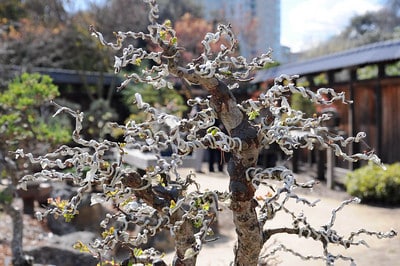
Hawthorn bonsai with paper-wrapped copper wire
Working with paper-wrapped wire isn’t bad – the trick is getting the paper on the wire. It takes a bit of practice. The paper is rolled onto a single section of wire at a time. The result is a funny looking tree – and if all goes well, there will be no scars.
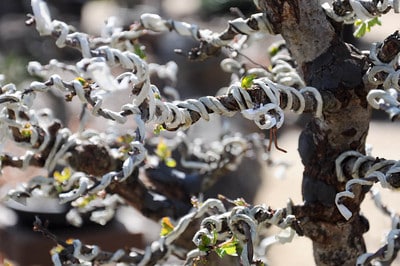
Hawthorn – wiring detail
The garden does a good job of providing information about the care and maintenance of the collection. The paper-covered wire treatment elicited its own note:
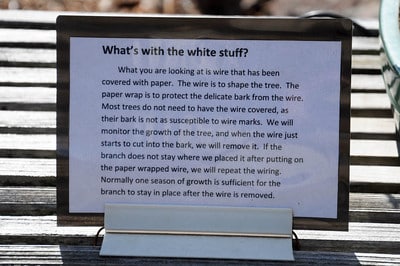
What’s with the white stuff?
What you are looking at is wire that has been covered with paper. The wire is to shape the tree. The paper wrap is to protect the delicate bark from the wire. Most trees do not need to have the wire covered, as their bark is not as susceptible to wire marks. We will monitor the growth of the tree, and when the wire just starts to cut into the bark, we will remove it. If the branch does not stay where we placed it after putting on the paper wrapped wire, we will repeat the wiring. Normally one season of growth is sufficient for the branch to stay in place after the wire is removed.
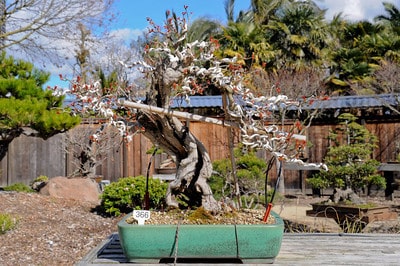
Pomegranate with paper-wrapped wire, bamboo sections and irrigation lines
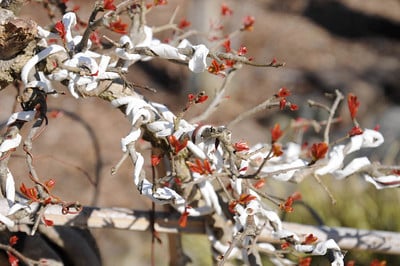
Pomegranate – wiring detail
The Garden at Lake Merritt’s website contains a lot of information about the trees in the collection. The weeping flowering cherry below, the site notes, is known as “shidare-higan-sakura in Japanese, or Prunus subhirtella.” It was donated by Pete and Amy Sugawara and was started some time around 1980.
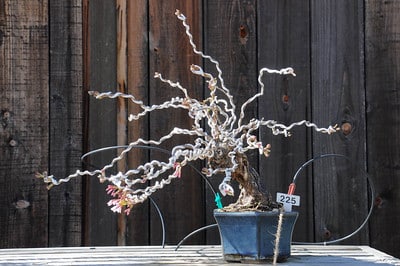
Weeping flowering cherry, ‘Benihoshi’
I don’t know where one can find the paper used for this technique – which is fine, for the moment, as I have a lot of pines to wire.
Subscribe to Bonsai Tonight
New Posts Delivered Every Tuesday and Friday
Michael says
From what I gathered in Japanese books, you can use almost any paper to wrap the wire… you can even use painter’s tape in a pinch. You start with a 1″ wide strip of paper, fold one short end back on itself then its sides towards the center to make a wedge shaped pocket. Put the end of the wire in that pocket and wrap the paper around the wire.
Hope that helps, if not I can try to make a drawing of the process.
xwires says
Thanks Michael, that does help. The technique you describe is about how I went about it. I twisted the wire in one hand and guided the paper around it with the other.
Scott Straley says
Jonas,
I noticed in the picture of the pomegranate that there is a wire that isn’t wrapped-is there a gauge size you don’t have to worry about wrapping? (i.e. 16 gauge and higher)
Interesting post.
xwires says
Good question Scott – I don’t have a good answer. If the point of wrapping the wire is to reduce staining or scarring the bark, then it’s less important to wrap smaller wires as they’ll leave less of a trace than larger wires. It’s also harder to wrap small gauge wires.
Stavros says
The paper wrap makes the wire thicker anyway, and it takes a lot of time and effort to wrap it. It also makes the tree unattractive….. So why not using coated aluminum wire in the first place???
LeeBee says
Kathy taught me that cutting temporary pleated window blinds into long strips works very well.
Kevin says
I haven’t tried it, but I have seen florists wrap wire very quickly with the florist tape. It’s a better color, with a stretchy, spongy quality. It’s easy and cheap to find at most craft stores.